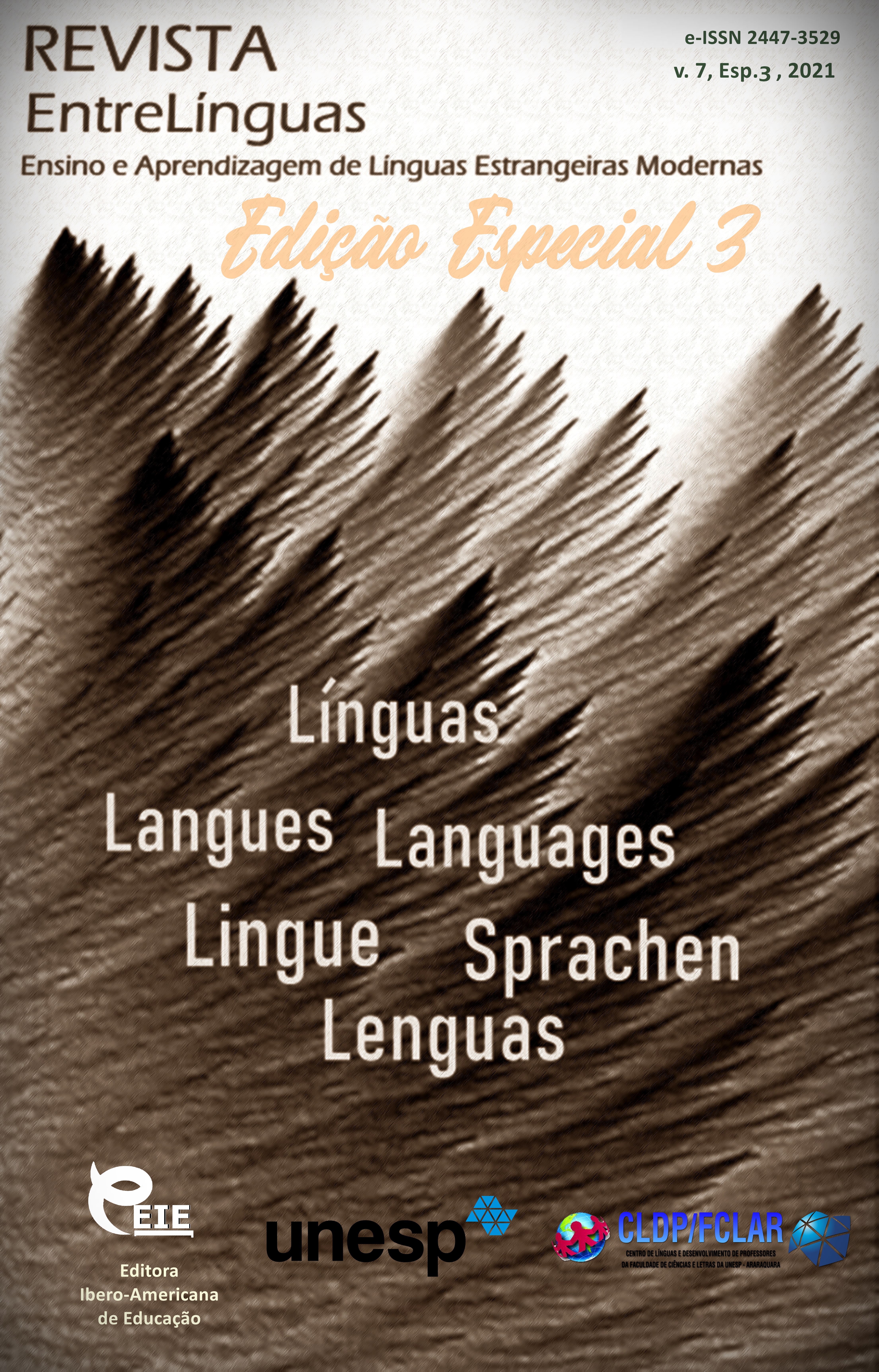Unidades fraseológicas com nomes de roupas em inglês, alemão e russo
DOI:
https://doi.org/10.29051/el.v7iesp.3.15715Palavras-chave:
Língua, Linguística, Cultura, Comunicação, Unidade fraseológicaResumo
O artigo trata da análise comparativa das unidades fraseológicas em inglês, alemão e russo com o componente “roupas”, ou seja, nomes de acessórios, vestuários, peças de vestuário e calçados. A relevância da pesquisa é definida pelo interesse na interação entre diferentes linguagens e o processo de comunicação intercultural no mundo moderno. Um estudo profundo de expressões definidas ajuda a aprender o sistema único de linguagem que é característico de seus falantes nativos. O estudo das unidades fraseológicas com os nomes das roupas abre oportunidades para a compreensão da cultura tradicional, material e espiritual de uma nação. O objetivo do estudo foi comparar unidades fraseológicas com o componente “roupas” de três línguas: inglês, alemão e russo e realizar a análise quantitativa dessas unidades. Os autores usaram métodos como descritivo, comparativo, interpretativo, método de amostragem contínua e método estatístico. O objeto de estudo são diferentes tipos de unidades fraseológicas, incluindo provérbios e ditados, com os nomes de roupas pertencentes a cinco grupos temáticos: “vestimentas”, “peças de vestuário”, “materiais de vestuário”, “acessórios” e “calçados”. O estudo revelou que os maiores grupos temáticos de unidades fraseológicas são aqueles com nomes de peças de roupas e acessórios.
Downloads
Referências
an International Interdisciplinary Journal, v. 21, n. 5, p. 1563-1572, 2018.
ANDREYEVA, Y. A. KORNEV, I. G. A.; SAKHIBULLINA, K. A. Values and anti-values in figurative phraseological units in the Russian and German languages. Humanities and Social Sciences Reviews, v. 7, n. 4, p. 427-432, 2019.
ARSENTEVA, E. F. New trends in lexicography: ways of registering and describing lexis. In: The main problems of multilingual phraseological dictionary compilation. Cambridge Scholars Publishing, 2010.
AYUPOVA, R. et al. Identifying the key components of phraseological units. Humanities and Social Sciences Reviews, v. 8, n. 1, p. 233-239, 2020.
BABIYAN, T. V. Proverbs and sayings as means of linguiocultural realia representation. Filologicheskie nauki. Voprosy teorii i praktiki, v. 10, n. 76, p. 48-50, 2017.
BINOVICH, L. E. Nemecko-russkij frazeologicheskij slovar’. Akvarium, 1995.
COWIE, A. P. Phraseology: theory, analysis and applications. Oxford University Press, 1998.
FEDOROV, A. I. Frazeologicheskij slovar’russkogo literaturnogo yazyka: ok. 13 000 frazeologicheskih edinic. Astrel: AST, 2008.
KOZLOVA, T.V. Kostyum kak znakovaya sistema (Suit as a sign system). MTI, 1980.
KUNIN, A. V. English-russian phraseological dictionary. Zhivoy yazyk, 1998.
LITVINOV, P. P. 3500 anglijskih frazeologizmov i ustojchivyh slovosochetanij. Astrel: AST, 2007.
NACISCIONE, A. Stylistic use of phraseological units in discourse. John Benjamins Publishing, 2010.
OXFORD DICTIONARY OF ENGLISH IDIOMS. Oxford University Press, 2009.
THE FARLEX IDIOMS AND SLANG DICTIONARY. CreateSpace Independent Publishing Platform, 2017.
Downloads
Publicado
Como Citar
Edição
Seção
Licença

Este trabalho está licenciado sob uma licença Creative Commons Attribution-NonCommercial-ShareAlike 4.0 International License.
Os manuscritos aceitos e publicados são de propriedade da Revista EntreLínguas. Os artigos publicados e as referências citadas na Revista EntreLínguas são de inteira responsabilidade de seus autores.
Transferência de direitos autorais – autorização para publicação
Caso o artigo submetido seja aprovado para publicação, já fica acordado que o(s) autor(es) autoriza(m) a UNESP a reproduzi-lo e publicá-lo na EntreLínguas, entendendo-se os termos “reprodução” e “publicação” conforme definição respectivamente dos incisos VI e I do artigo 5° da Lei 9610/98. O artigo poderá ser acessado pela rede mundial de computadores (Internet), sendo permitidas, a título gratuito, a consulta e a reprodução de exemplar do artigo para uso próprio de quem a consulta, desde que haja a citação ao texto consultado. Essa autorização de publicação 328 EntreLínguas, Araraquara, v. 1, n .2, p. 323-328, jul./dez. 2015 não tem limitação de tempo, ficando a UNESP responsável pela manutenção da identificação do(s) autor(es) do artigo. Os artigos publicados e as referências citadas na Revista EntreLínguas são de inteira responsabilidade de seus autores.











